Is it an underhanded compliment to be called the most innovative company in the newspaper business?
The Washington Post will happily take it. In the three years since Amazon’s Jeff Bezos bought the Post for $250 million—now seen as a steal for one of the great brands in publishing—the Post has reinvented itself with digital speed. Its Web traffic has doubled since Bezos arrived, and it far outstrips The New York Times (and even BuzzFeed) in the number of online posts its reporters file every day. So successful has the Post become in the digital game that it now licenses its content management system to other news outlets, a business that could generate $100 million a year.
It is a moment to savor for a once-iconic family business that has spent much of the last decade in retreat. When Bezos bought the Post in 2013, its news franchise had been decimated by Politico (which will soon celebrate its 10th anniversary); it had lost its editor; and its digital business had four years earlier joined the mothership from an office in Arlington.*
Today, the office has the feel of a tech startup well-blessed by the VC gods. Video screens scrolling Web analytics hang above the newsroom. Reporters roam the place carrying laptops.
The Post’s turnaround, in a terrible period for newspapers, has made Martin Baron, its editor, a journalism rock star (Pulitzer Prize, dominating coverage of the 2016 election, portrayal by Liev Schreiber in an Oscar-winning movie). But it has also raised the profile of the paper’s tech team, who have become stars in their own right on the digital-media conference circuit. If a paper like the Post can right itself digitally, perhaps there’s hope for everyone else.
There most certainly could be, if everyone else were owned by a billionaire who sees today’s media game as analogous to the internet circa 1999, essentially a land grab open to whomever can spend the most money and move the fastest to grab the biggest market share. That is the story of the rise of Amazon.com, and Bezos is applying many of those same lessons to the Post. (Along with an obsession with Web traffic and engagement metrics, which are much more important internally than whether the paper makes any money.)
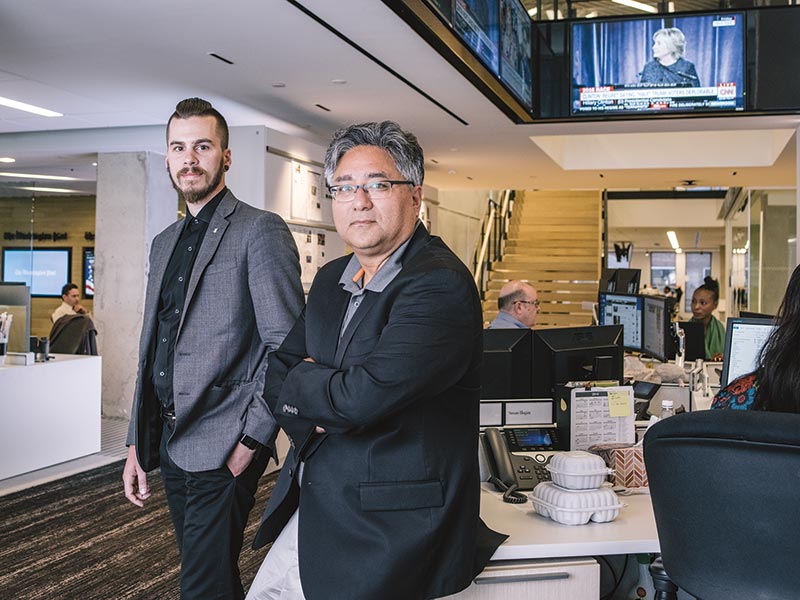
Marburger, left, and Prakash in the newsroom (Greg Kahn)
The Post, working with Google, also has moved aggressively to make its mobile site load stories faster, on the assumption (anathema to reporters) that readers will choose news outlets based in part on how fast they are. Another tool at the company, for Web scheduling, automatically hounds reporters missing their deadlines.
The pair Bezos has chosen to pull off all of this could not be more of an odd work couple. Shailesh Prakash, the Post’s chief information officer, is an old-school technologist, with stints at Microsoft and Netscape, and no experience in media before joining the Post five years ago. He is as corporate (khakis and button-down shirt) and conventional, at least in appearance, as his technology partner at the Post is not.
Joey Marburger, the paper’s director of product, was dubbed the Post’s “punk rock star” by Digiday.com, no doubt due to the ear studs and the fact that he played bass in a punk band in high school. Marburger is the journalist of the duo, working his way up from features editor at the Purdue student newspaper to the Indianapolis Star and Gannett before landing at the Post in 2010.
Today, Prakash and Marburger are the newspaper’s digital killers. They talk more to Bezos than anyone else in the newsroom, including Baron. That makes them critical to the continued success of the Post, but also important players in the future of newspapers, as owners and editors around the world increasingly look to the Post as a turnaround that is working (albeit one made easier by what must seem to competitors like a bottomless Bezos checkbook).
Prakash and Marburger talked to CJR Editor and Publisher Kyle Pope in the Post newsroom about their boss, how they convince print reporters and editors to think digitally, and where the newspaper industry now sits on the innovation curve. An edited transcript follows.
CJR: There is a lot of angst in the industry about the business model of newspapers. How do you feel about your progress in solving the question?
Shailesh Prakash: The first thing we all have to accept is that no one has figured it out. If no one has figured it out, then I don’t see any other option than to try and experiment.
CJR: In other words, doing things the way they’ve been done is out of the question.
SP: I think so. So the next question I get asked—and it’s a valid question—is how much will this experimentation cost? Can you afford it? Is it just because Bezos is giving you money?
First I think there’s a flaw in the [notion] that experimentation means gobs and gobs of money. It doesn’t have to.
Let’s take a couple of examples. Right now, we are partnering with Google on an ultra-fast mobile site. As of this instant, there’s a little less than 10 percent of our traffic that’s flowing into it. Now let’s say we find that it doesn’t work, or it needs a lot of extra work. It’s an option to shut it down.
You haven’t done the traditional ‘Let’s make a great plan, let’s hire the engineers, let’s then build it out, then oops, it didn’t work.’
CJR: Let’s just get back to how that relates to the business model question. The issue to be addressed here is that one of the big impediments you have to growing your audience is the time it takes for stories to load. So you improve that through this mobile technology and you get more people to come to your site. But then what?
SP: What will actually come of that is an open question. Will subscribers pay for an extra-fast site? Will ad blockers stop blocking sites that don’t have the wait time that they’re used to? These things are unknown. But it begins with trying an experiment.
And then there’s a little bit of tangential business model. How much will other publishers pay us if we could improve their mobile site not just a little bit, but significantly? Can I sell that technology to them?
If a paper like the Post can right itself digitally, perhaps there’s hope for everyone else.
CJR: The idea that readers will pay extra for speed is intriguing. You see that as likely?
SP: I think so. It’s been proven over and over again that speed matters. In some industries, the correlation is more direct, like in retail. You have a site and you change nothing except it becomes much faster, you see the sales change.
Joey Marburger: If you’re used to a lot of other slow mobile sites out there, specifically news, and you come to us and it’s significantly faster, you may be more likely to come to us on a regular basis. And you’re more likely—which we see already in the data—to consume more content, hit the subscription meter faster, consume more ads, you name it.
CJR: So you think news consumers in the future will make a decision on which Hillary Clinton story to click on based on speed? If they see a number of options and their experience tells them that The Washington Post is faster, then they’re going to read that one?
SP: Yes. And we see that already. I don’t know if it’s a conscious choice. I think it’s more about not hesitating to click.
CJR: I can’t imagine that’s a popular view in the newsroom.
JM: Well, it doesn’t really change our editorial strategy in any way. Everyone is peppered with links and headlines. But you don’t always know what the story’s going to be or if it’s what you are looking for. But if you try it and it’s super-fast, you’re more likely to try something else. But if it’s more than three seconds or four seconds every time, you’re not going to try.
SP: It was Bezos who brought this up. He said that when Amazon made the Kindle, they didn’t think, ‘Let’s get rid of the book and come up with a new way to read books.’ Their whole approach was, ‘How can we keep everything that’s fantastic about a book and also add in the gifts of digital?’
He mentioned that when you read a newspaper, the ease with which you browse it is so much better than digital browsing. He called it cognitive overhead. So a lot of our design choices have been to reduce cognitive overhead. And speed is a big factor. You don’t expect that when I open up this newspaper I’m going to wait. It’s there. It’s beautiful. It’s relaxing.
CJR: But what an interesting idea, that this could be important in terms of how young people view news, which is that they view it as stodgy and old-fashioned. And it could have something to do with the time it takes to download?
This brings us to the content management system that you’re marketing to other news organizations. Do you see this as one day becoming its own company?
SP: It’s a thing we talk about. It’s in its infancy. I don’t know.
CJR: Is that your ambition for it?
SP: The biggest deterrent for us selling this technology is not that there’s no demand. It’s not that we’re in a crowded marketplace. Most newsrooms have already concluded that there isn’t a market leader out there, so they’re very open to discussion. The second thing is that I don’t have a worry that this tech doesn’t work. We’ve been working on it for five years. We’ve overhauled The Washington Post, gutted it, and done it again. And it runs a 700-person newsroom that’s very, very finicky. These guys are on it, they are demanding. Joey sits in the newsroom, he hears from them every day.
When you go and say, ‘I’ve got this thing,’ they say, ‘Really? You built it? The Washington Post?’ If it was Amazon and they said, ‘We’ve come up with this publishing platform,’ would there be so much hesitation?
Speed is a big factor. You don’t expect that when I open up this newspaper I’m going to wait. It’s there. It’s beautiful. It’s relaxing.”
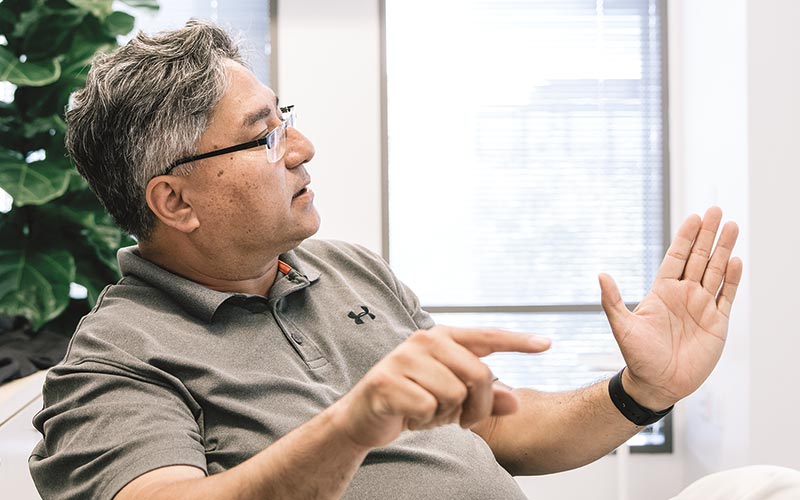
CJR: Shailesh, you’re relatively new to the newspaper industry. There seems to be this love-hate relationship with digital technology and what it’s done to this industry. It’s offered this enormous opportunity, and it’s also offered enormous pain. How open-minded are people when you come to them with something like this?
SP: I’ve been here five years, and I think I’ve seen a shift. I don’t think we are at a point where everything is enthusiastically embraced right away, even if it makes either intuitive sense or if there’s data to prove it. There’s often, ‘Do you really think we need to do that?’ So it’s there, but there’s significantly less friction now than there was.
CJR: Back to the culture issues. Would we even be having this conversation if this company had not been bought by a technology company? Could a newspaper have made these changes organically?
JM: I think some of them, yes, but it would have taken a little bit longer. It’s been three years since Jeff bought us. I’d say we’d probably be where we are maybe five to seven years from now. And who knows if we would’ve done half of what we’ve gotten done. But Jeff didn’t just reach down to the newsroom and say here’s a brand-new culture, here’s a bunch of things you should do, here’s what Amazon does, so you should copy it. The sheer thought of him spread throughout the company. Over night, we thought there wasn’t much we couldn’t do. People were a little more accepting of things.
SP: He’s also made some very strong changes in the compensation model. The number one criteria that grows our compensation used to be operating income. Did you or did you not hit the operating income target that was agreed upon at the beginning of the year? It was crystal clear whether you got your bonus or not. We were all in it together. When revenue was slowing and operating income is the target, then what do you do? You cut costs. There’s no other way out.
When Jeff bought us, within about six months, he threw that out. Now there are three other criteria. It’s basically: How fast do you move? It’s very subjective. The second one is that there are no sacred cows, to push experimentation. The third thing is debate, but commit. So you can argue all you want, but once we agree, then there’s no undermining. Those are the three things that now very subjectively drive the compensation.
CJR: So does profitability factor in at all?
SP: No. It’s those three things.
CJR: In my experience, journalists don’t care whether you make any money.
SP: I have been in meetings where it is clear that it is not an option for us to simply say, ‘Okay, this year we need this much money, and this year we need that much.’ We are working very hard to make sure we are a profitable enterprise. That is very important.
JM: This is still a job, and you still have to hit certain marks. Everything is just framed in a different way. When you have enough people rallied, it’s a lot more fun. If you feel like all you are doing is bean counting, then it’s not being creative and it’s not fun.
So now when I go to a producer or editor or reporter or whoever and say, ‘Hey, we want to try an experimental thing, we don’t really know what this means but we’ll give it a shot and see where it goes. Would you be into that?’ They’re like, ‘Yes.’ Before we had to really convince people.
Innovation thrives in companies where design is respected. But design at all levels. There was a time when people would come to me with ideas and I would say no all the time. It was better for me to teach people to be creative than go off and say I’m the only one with all these creative ideas. That doesn’t really help.
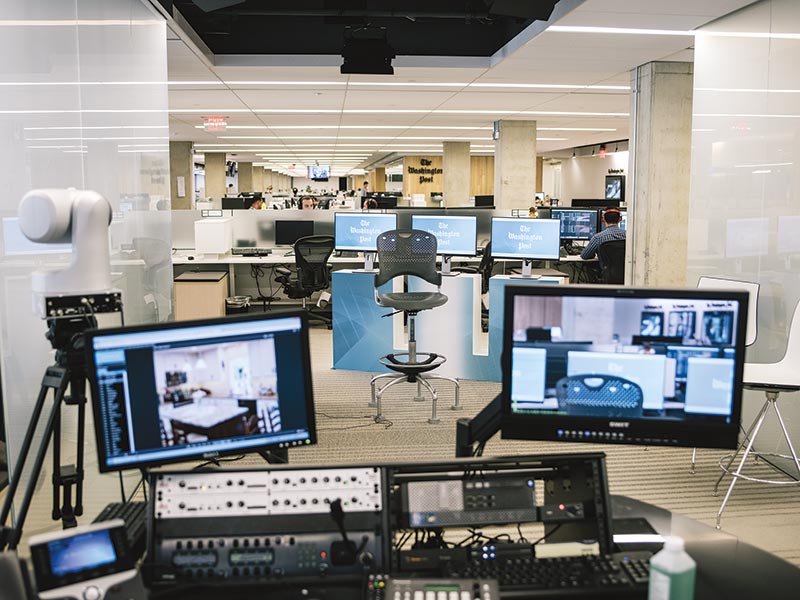
Inside the newsroom (Greg Kahn)
CJR: The Post is very prolific on Apple News, on Facebook, and you do a lot of partnerships in terms of giving away content. What is your thinking in terms of traffic versus revenue?
JM: We’re starting to think well ahead in shifting that a little bit. But we don’t want to stop growing audience just to make a quick buck, either. We still have to scale up the audience. I still feel there’s a huge land grab on the internet, especially in media. But eventually, you do have to start converting people.
CJR: It’s reminiscent of the growth of the Web, a land grab where you get people in. Newspapers are the internet, circa 1999?
SP: In general, that’s a correct metaphor. For the Post there are some nuances. We had for a very long time a tag line that said ‘For and About Washington.’ One of the big changes and explicit changes in strategy has been to go after a national and international audience. One of the things we’ve tried to do is to look at platforms we might be able to over-index on to get there faster. Take Facebook. One in seven humans visits Facebook every day. It’s not possible to grow nationally and internationally if you say, ‘I will send them 10 articles.’ If we want to grow nationally and internationally it is really not an option to just ignore that platform.
CJR: So let’s talk about the newsroom culture here. I read that Post reporters produce twice the number of online stories with a newsroom of 700 as New York Times reporters, which has a newsroom of 1,300. That in itself is a telling fact of the embrace of this. How has that happened?
JM: We hired a lot more digitally savvy reporters over the past three years. They understood that to write for the internet, you had to be a little more prolific.
Also, how we write stories and how we approach them has changed. There may be one news peg for one story, but we’ll write it in a hundred different ways. Look at the Hillary Clinton illness story: the video, the combination of videos, the analysis, the tick tock, the narrative. We actually drove the story forward. We’re owning more stories digitally than we ever have.
The sheer thought of [Jeff Bezos] spread throughout the company. Overnight, we thought there wasn’t much we couldn’t do.”

CJR: I’ve noticed that digital openness, if that’s what you want to call it, isn’t necessarily correlated to age. How would you very broadly describe who is able to make that switch?
JM: It’s the same qualities that make a good journalist, period. They just have to switch the way they think about things a little bit. What if we were printing the paper every hour and your story was going to be on A1? That’s happening today. Journalists are smart, passionate, curious people. And if it’s applied in the right way to digital news, then it just takes off.
Also, we’re really lucky to have one of the best editors in the world in Marty Baron, who believes in digital news and it’s all he really talks about.
SP: We also have this tool called Websked, which is now in the newsroom, where basically now for the first time there is a central command where the editors can see what’s being worked on across the newsroom—in video and photography and blogs.
You need to input a time to end—when do you think that story you’re writing is going to be ready? As your time draws near, the desk will send a reminder: Hey, your story is due in an hour. We see you haven’t yet finished the third paragraph. You see the curve every day of how many pieces of content were published by hour.
Marty sets a curve that he wants. He wants 30 percent of it at 9 am. We own the URL America’s First Read. We want to move that curve. There is the culture, then there are the tools that enable that culture to flourish.
CJR: You talk a lot about being product-focused. What is the product here? Is it the journalism?
SP: It’s part of it, I think. But everything else is as important: the features on the product, can you save a story for later, is it on the platforms, the speed, the crash rate. All of these are parts of the product that ultimately have to go hand in hand with the journalism.
CJR: Journalists traditionally have had a hard time accepting this notion that journalism is a product that isn’t just journalism. I think that’s a hard shift for people to make.
SP: The penetration and enthusiasm around that concept is palpable at the Post. Jeff’s a product guy. We talk to him every two weeks. That’s what he talks to us about.
CJR: Less than a journalism guy.
SP: Oh yes, he’s a product guy. And having that person at the top smooths the transition significantly. People just understand what’s expected. It’s in the air. It’s in the water.
CJR: But I do think that if there wasn’t someone like Marty Baron to balance it out, people would freak out.
SP: Absolutely. I 100-percent agree. And there are examples in the industry of that pure Silicon Valley approach. Jam too much medicine in and the patient will die.
*This sentence has been rewritten to reflect that the Post‘s digital operation moved to the paper’s downtown DC headquarters in 2009.
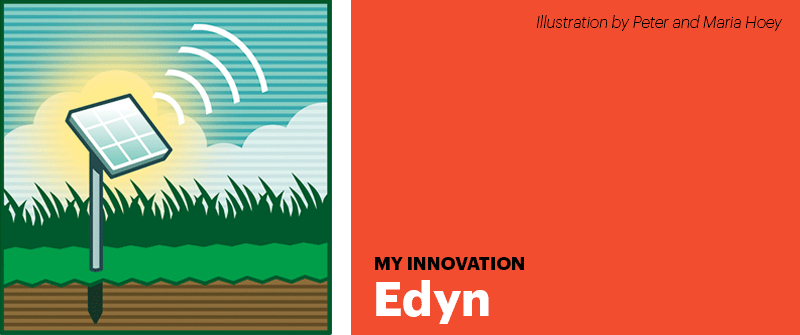
Everybody needs a way to decompress. I decompress by gardening. An innovation that has made my gardening so much more precise is a little solar-powered device called Edyn. It’s literally a solar-powered spike that you can push into your flower or plant beds and it will relay information about moisture, nutrient-levels, soil temperature, and sun exposure to your phone/online. What’s really been so great about this little Internet Of Things innovation is that it has helped encourage my kids to garden with me. It helps them manage their gardening projects and marvel at the beautiful things they are able to grow when the water and nutrients are right.
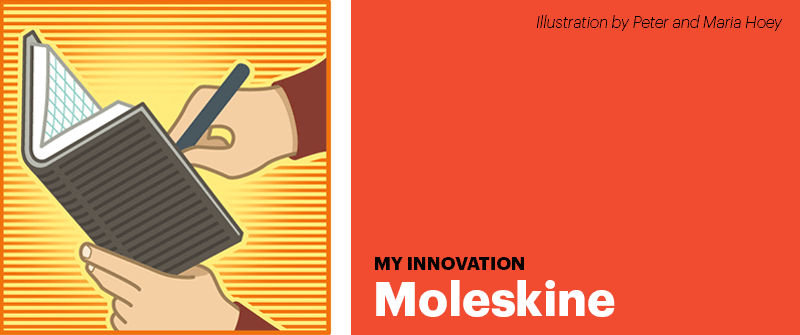
Although it’s very low-tech, Moleskine notebooks have been something I’ve used to take notes and capture ideas for years. I have a library of them I’ve filled throughout my career. I carry a standard-sized, graph paper version with me all the time. The notebooks themselves aren’t necessarily the innovation, but rather the method of note-taking I’ve come to create for myself. The low-tech factor keeps me focused when I’m sketching something or writing down an idea. It’s so easy to get distracted on a digital device that I think the non-digital aspect of these notebooks helps me be more innovative.


